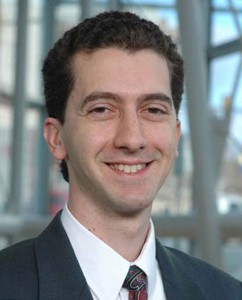
Dario Salvucci discussed the advances made in modeling multitasking in the latest lecture in the College of Engineering’s Dean’s Lecture Series. The talk, titled “Walk, Text, and Chew Gum: A Computational Approach to Understanding Human Multitasking,” was presented May 14 in Mitchell Auditorium.
Salvucci, an alumnus of both Princeton University and Carnegie Mellon University, began the lecture by reviewing the various activities that fall under the banner of multitasking. He highlighted distracted driving as “the most salient and the most newsworthy these days.”
The audience was given an abridged version of multitasking theory. Salvucci focused on the concept of threaded cognition, an idea that he and other collaborators developed to describe and predict the effects of multitasking.
“The idea is that you have these threads of thought in your head that can be expressed computationally, and then you want to try and predict how these threads can interact with one another,” Salvucci explained.
Referencing Albert Einstein, Salvucci continued on to describe the brain as a “thought kitchen.” While the brain has a number of resources available, it is ultimately limited by the capacity of a central processor, just as a chef can only cook so many dishes at a time. The theory points to the basal ganglia of the brain as the limiting factor in our ability to multitask.
Salvucci and his colleagues aimed to understand more about the nature of this procedural pileup. They developed a model using a programming language with human flaws and capabilities. This model was incorporated into a driving scenario and used to measure the effect of distractions while driving. The driving model is a central feature in a device named “Distract-R,” which allows users to predict the degree of distraction caused by different tasks, such as tuning the radio or dialing a phone number.
Ford Motor Co. collaborated with Salvucci and his team to test the validity of the model. While it was difficult to express the effects of different multitasking activities quantitatively, the rank order of the interfaces of the tasks ended up being good for the test.
“We may not have the numbers exactly right, but we may be able to say that a certain way of using this radio is a lot more efficient than the different way,” Salvucci said. Considering the accuracy and convenience of the model, Salvucci hopes that it will one day reduce the amount of human testing. Taking human subjects off the road while testing potentially dangerous multitasking would not only save time and money but would also serve to make this line of research safer.
Now that there is a reliable model of distracted driving, researchers hope to expand this study to observe the effects of multiple distracted drivers with the use of variables such as traffic and commute time. Preliminary research shows that one distracted driver in a group of 20 cars can, in fact, produce a significant ripple effect. Salvucci went on to say that the future of driving is heading toward an age where vehicles will intake far more information than they do currently. For example, a driver may be able to communicate with adjacent vehicles or may receive a warning projected into his car from a red light. This upcoming influx of potential distractions poses both advantages and disadvantages for drivers, which can be evaluated by understanding the effects of multitasking.
Salvucci concluded his talk by explaining the societal implications of his research and the emerging debates on distracted driving. “This sort of underlying science and engineering is really important to give us more information to make these kinds of decisions.”
The post Multitasking strains brain resources appeared first on The Triangle.
